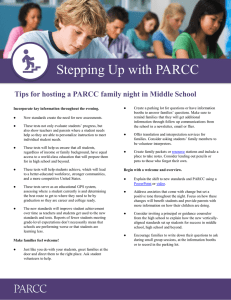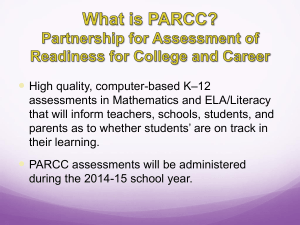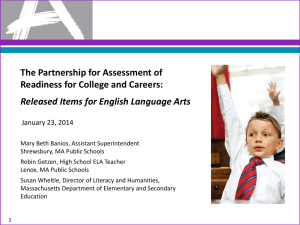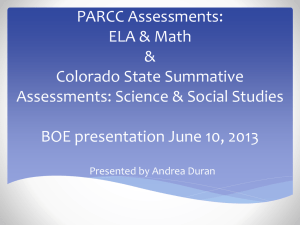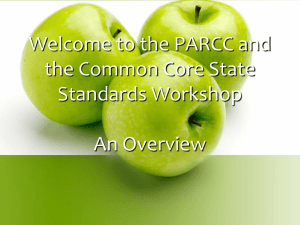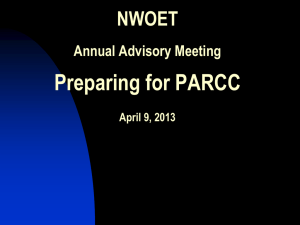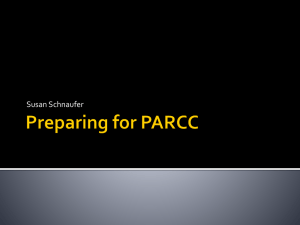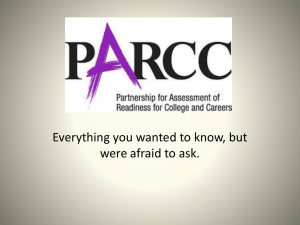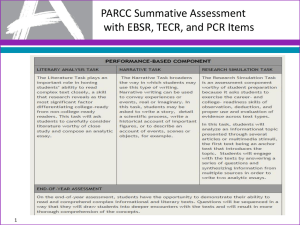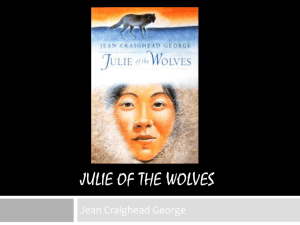PARCC ELA Sample Items Overview PPT
advertisement
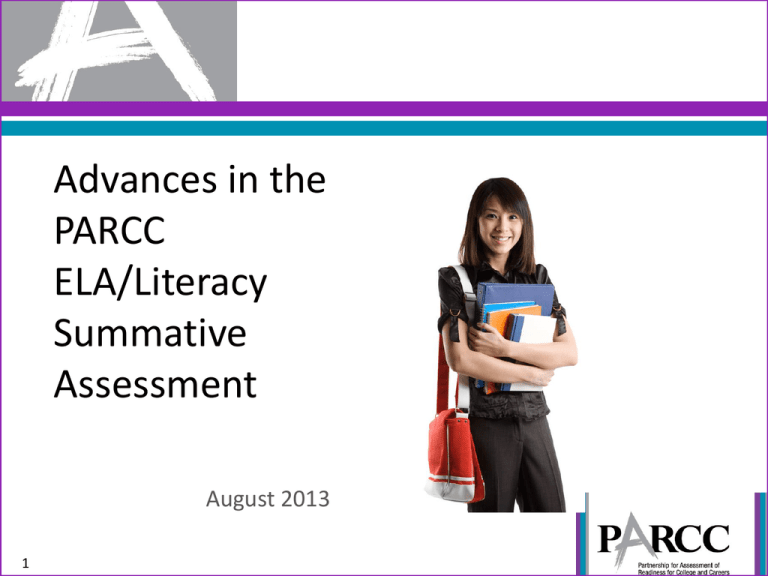
Advances in the PARCC ELA/Literacy Summative Assessment August 2013 1 PARCC’s Fundamental Advance PARCC is designed to reward quality instruction aligned to the Common Core State Standards, so the assessment is worthy of preparation rather than a distraction from good work. 2 PARCC’s Core Commitments to ELA/Literacy Assessment Quality • Questions Worth Answering: Sequences of questions that draw students into deeper encounters with texts are the norm (as in an excellent classroom), rather than sets of random questions of varying quality. • Texts Worth Reading: The assessments use authentic texts worthy of study instead of artificially produced or commissioned passages. • Better Standards Demand Better Questions: Instead of reusing existing items, PARCC is developing custom items to the Standards. • Fidelity to the Standards: PARCC evidence statements are rooted in the language of the Standards so that expectations remain the same in both instructional and assessment settings. 3 What is Different About PARCC’s Development Process? • PARCC states first developed the Model Content Frameworks to provide guidance on key elements of excellent instruction aligned with the Standards. • Then, those Frameworks informed the assessment blueprint design. So, for the first time. . . • PARCC is communicating in the same voice to teachers as it is to assessment developers! • PARCC is designing the assessments around exactly the same critical content the standards expect of teachers and students. 4 What Are the Shifts at the Heart of PARCC’s Design (and the Standards)? 1. Complexity: Regular practice with complex text and its academic language. 2. Evidence: Reading and writing grounded in evidence from text, literary and informational. 3. Knowledge: Building knowledge through content rich nonfiction. 5 The CCSS Shifts Build Toward College and Career Readiness for All Students Nine Specific Advances in the PARCC ELA/Literacy Summative Assessment Demanded by the Three Common Core Shifts. . . 7 Shift 1: Regular practice with complex text and its academic language 1. PARCC builds a staircase of text complexity to ensure students are on track each year for college and career reading. 2. PARCC rewards careful, close reading rather than racing through passages. 3. PARCC systematically focuses on the words that matter most—not obscure vocabulary, but the academic language that pervades complex texts. 8 Shift 2: Reading and writing grounded in evidence from text, literary and informational 4. PARCC focuses on students rigorously citing evidence from texts throughout the assessment. 5. PARCC includes questions with more than one right answer to allow students to generate a range of rich insights that are substantiated by evidence from text(s). 6. PARCC requires writing to sources rather than writing to decontextualized expository prompts. 7. PARCC also includes rigorous expectations for narrative writing, including accuracy and precision in writing in later grades. 9 Shift 3: Building knowledge through content rich nonfiction 8. PARCC assesses not just ELA but a full range of reading and writing across the disciplines. 9. PARCC simulates research on the assessment, including the comparison and synthesis of ideas across a range of informational sources. 10 Students’ Command of Evidence with Complex Texts is at the Core of Every Part of the Assessment! SO. . . Two standards are always in play—whether items are focused on reading or writing. These standards are: – Reading Standard One (Use of Evidence) – Reading Standard Ten (Complex Texts) 11 Three Innovative Item Types That Showcase Students’ Command of Evidence with Complex Texts • Evidence-Based Selected Response (EBSR)—Combines a traditional selected-response question with a second selected-response question that asks students to show evidence from the text that supports the answer they provided to the first question. Underscores the importance of Reading Anchor Standard 1 for implementation of the CCSS. • Technology-Enhanced Constructed Response (TECR)—Uses technology to capture student comprehension of texts in authentic ways that have been difficult to score by machine for large scale assessments (e.g., drag and drop, cut and paste, shade text, move items to show relationships). • Prose Constructed Responses (PCR)—Elicits evidence that students have understood a text or texts they have read and can communicate that understanding well both in terms of written expression and knowledge of language and conventions. There are three of these items of varying types on each annual performance-based assessment. 12 Questions Worth Answering: Items demonstrate: – Sequences of questions that draw students into deeper encounters with texts (as in an excellent classroom), rather than sets of random questions of varying quality. – Opportunities for students to demonstrate what they know, rather than what they don’t know; items allow for partial credit – Purposeful options for student expression of divergent thinking – Use of technology to allow students to construct meaning for machine-scorable items 13 Understanding the Literary Analysis Task • Students carefully consider two literary texts worthy of close study. • They are asked to answer a few EBSR and TECR questions about each text to demonstrate their ability to do close analytic reading and to compare and synthesize ideas. • Students write a literary analysis about the two texts. 14 Understanding the Research Simulation Task • Students begin by reading an anchor text that introduces the topic. • EBSR and TECR items ask students to gather key details about the passage to support their understanding. • Students read one (Grade 3) or two additional sources (Grades 5 and 6) and answer a few questions about each text to learn more about the topic, so they are ready to write the final essay and to show their reading comprehension. • Finally, students mirror the research process by synthesizing their understandings into a writing that uses textual evidence from the sources. 15 Texts Worth Reading: Grade 3 • Two of the sample items measure student understanding of an excerpt from a book titled. • The Prose Constructed Response (PCR) item also measures student understanding of “The Peanut Man,” an article about George Washington Carver. 16 Grade 3, Item #1—Part A The article includes these details about life: • She wrote newspaper articles to tell others about what she saw in Alaska to inform those who had not been there. (paragraph 1) • She wrote the first guidebook about Alaska. (paragraph 1) • She was the first woman to work at the National Geographic Society, where she wrote many articles and books. (paragraph 11) What do these details help show about? a) They show that she shared the benefits of her experiences with others.* b) They show she had many important jobs during her lifetime, but becoming a photographer was one of her proudest moments. c) They show that her earlier travels were more exciting than the work she did later in her life. d) They show that she had a careful plan for everything she did in her life. Grade 3, Item #1—Part B Ideas from paragraphs 1 and 11 were used to help you learn about her. Click on two other paragraphs that include additional support for the answer in Part A. There are more than two paragraphs that include additional support, but you need to only choose two. Grade 3, Item #2—Part A Which statement best describes how the events in paragraphs 13 through 15 are related to each other? a) They explain how Washington, D.C., would change if cherry trees were planted around the city. b) They show that found a new way to get cherry trees planted in Washington, D.C.* c) They compare the ways and Mrs. Taft tried to add beauty to Washington, D.C. d) They describe how Mr. gave the idea to bring cherry trees to Washington, D.C. Grade 3, Item #2—Part B Which sentence from the article best supports the answer in Part A? Grade 3, Item #3 You have read two texts about famous people in American history who solved a problem by working to make a change. Write an article for your school newspaper describing how she and faced challenges to change something in America. – In your article, be sure to describe in detail why some solutions they tried worked and others did not work. – Tell how the challenges each one faced were the same and how they were different. Understanding the Narrative Writing Task • Students read one brief text and answer a few questions to help clarify their understanding of the text(s). • Students then write a narrative story. 22 Texts Worth Reading: Grade 6 • Julie of the Wolves was a winner of the Newbery Medal in 1973. • This text, about a young Eskimo girl surviving on her own in the tundra by communicating with wolves, offers a story rich with characterization and imagery that will appeal to a diverse student population. 23 Grade 6, Item #1—Part A Which statement best describes the central idea of the text? a) Miyax is far from home and in need of help. * b) Miyax misses her father and has forgotten the lessons he taught her. c) Miyax is cold and lacks appropriate clothing. d) Miyax is surrounded by a pack of unfriendly wolves. Grade 6, Item # 1—Part B Which sentence best helps develop the central idea? a) “Miyax pushed back the hood of her sealskin parka and looked at the Arctic sun.” b) “Somewhere in this cosmos was Miyax; and the very life in her body, its spark and warmth, depended upon these wolves for survival.”* c) “The next night the wolf called him from far away and her father went to him and found a freshly killed caribou.” d) He had ignored her since she first came upon them, two sleeps ago.” Grade 6, Item #2—Part A What is the purpose of this sentence in paragraph 1: “No roads cross it; ponds and lakes freckle its immensity”? a) It illustrates the theme that human beings should keep the natural would pure and unpolluted. b) It shows how beautiful the setting seems to Miyax. c) It helps develop the theme that nature connects all living things together. d) It emphasizes how the setting of the story creates great challenges for Miyax.* Grade 6, Item #2—Part B Which other sentence from the story serves a similar purpose? a) “Quietly she put down her cooking pot and crept to the top of a dome-shaped frost heave, one of the many earth buckles that rise and fall in the crackling cold of the Arctic winter.” b) “They were wagging their tails as they awoke and saw each other.” c) “Winds scream across it, and the view in every direction is exactly the same.”* d) “Unfortunately, Miyax’s father never explained to her how he had told the wolf of his needs.” Grade 6, Item #3—Part A (Prototype) What does the word regal mean as it is used in the passage? a) b) c) d) generous threatening kingly* uninterested Grade 6, Item #3—Part B (Prototype) Which of the phrases from the passage best helps the reader understand the meaning of regal? a) b) c) d) “wagging their tails as they awoke” “the wolves, who were shy” “their sounds and movements expressed goodwill” “with his head high and his chest out”* Grade 6, Item #4—Part A (Prototype) Based on the passage from Julie of the Wolves, how does Miyax feel about her father? a) b) c) d) She is angry that he left her alone. She blames him for her difficult childhood. She appreciates his thorough knowledge of nature.* She is grateful that he planned out her future. Grade 6, Item #4—Part B (Prototype) Which sentence from the passage best shows Miyax’s feelings for her father?” a) “She had been lost without food for many sleeps on the North Slope of Alaska.” b) “This could be done she knew, for her father, an Eskimo hunter, had done so.”* c) “Unfortunately, Miyax’s father never explained to her how he had told the wolf of his needs.” d) “And not long afterward he paddled his kayak into the Bering Sea to hunt for seal, and he never returned.” Grade 6, Item #5—Part A (Prototype) Choose one word that describes Miyax based on evidence from the text. There is more than one correct choice listed below. a) b) c) d) e) f) reckless lively imaginative* observant* impatient confident Grade 6, Item #5—Part B (Prototype revised to create sample item) Drag and drop two details from the passage that support your response to Part A into the box labeled “Supporting Details.” Supporting Details Grade 6, Item #6 (Prototype) In the passage, the author developed a strong character named Miyax. Think about Miyax and the details the author used to create that character. The passage ends with Miyax waiting for the black wolf to look at her. Write an original story to continue where the passage ended. In your story, be sure to use what you have learned about the character Miyax as you tell what happens to her next. Understanding the End-of-Year Assessment • Students will be given several passages to read closely. • EBSR and TECR questions will be sequenced in a way that they will draw students into deeper encounters with the texts and will result in thorough comprehension of the concepts that can also provide models for the regular course of instruction. • These tasks will draw on higher order skills such as critical reading and analysis, the comparison and synthesis of ideas within and across texts, and determining the meaning of words and phrases in context. 35 Texts Worth Reading: Grade 5 The sample items provide students an opportunity to read an article and a corresponding side bar piece on the same topic. 36 Grade 5, Item #1—Part A What is the meaning of the word dictate as it is used in paragraph 23? a) b) c) d) hint fix understand decide* Grade 5, Item #1—Part B Which phrase helps the reader understand the meaning of dictate? a) b) c) d) “recreate the tree house” “determine the shape”* “is less expensive to build” “has all the time in the world” Grade 5, Item # 2 Choose the two correct main ideas and drag them into the empty box labeled “Main Ideas.” Then choose one detail that best supports each main idea. Drag each detail into the empty box labeled “Supporting Details.” Possible Main Ideas Possible Supporting Details Jonathan has his own 1000-yard zipline. "In fact, as a tree house architect, Jonathan has built more than 380 custom tree houses across the United States."* Jonathan is an experienced tree house “Jonathan’s love of tree-house living builder.* began when he was a kid.” Jonathan works carefully so that tree houses do not hurt the trees.* Jonathan lived in a tree house when he was in college. Jonathan advises readers to learn the names of trees. "It was the most fun I ever had." "'I build a tree house so it helps the tree,' he says."* "'Walk in the woods and learn the different trees. Spend time climbing and learn how to do it safely.'" Jonathan once built a house in a crab “One of his favorite names is ‘Ups and apple tree. Downs.’” Main Ideas Supporting Details Grade 5, Item #3—Part A What is the purpose of the braces described in paragraph 6 of the article? a) They fix broken tree limbs, so a tree house will not fall down. b) They lock several trees together, so almost any kind of tree can be used. c) They join two trees into one unit, so a tree house looks secure. d) They help trees hold up a tree house, so the trees will not break.* Grade 5, Item #3—Part B Which two details from the article help support the answer to Part A? a) “Designing unique tree houses may sound tough, but Jonathan says it's no sweat.” b) "’Hardwoods such as oak, maple, or hickory make the best trees for houses—but I did once build a wonderful tree house in a crabapple tree.’” c) “’My tree house is in two trees—an oak and a fir—and has three posts to support the weight.’”* d) “As a certified arborist, Jonathan tries to never harm the trees.”* e) "The tree's center of gravity is at the top and the ends of its branches, so I build a house down at the center of the tree. . . ” f) "The tree grows over the artificial limbs, and they become part of the tree, . . .” Grade 5, Item #4—Part A Which idea is found in both the article about Fairoaks and the side bar about Nelson? a) Each tree house should be special for its owner.* b) People should climb trees for practice before building a tree house. c) Having a tree house is good for people. d) Going to a tree house school can be helpful in getting started. Grade 5, Item #4—Part B Choose one detail from the article and one detail from the side bar that support the answer to Part A. Drag each of the details into the box labeled "Supporting Details." Supporting Detail from Article Supporting Detail from Side Bar Summary of Items Released August 2013 • Grade 3 – EBSR, TECR, and PCR items that demonstrate the types of items PARCC will use to measure reading for information, reading vocabulary, written expression, and knowledge of language and conventions claims on a research simulation performance-based assessment task. • Grade 4 – A sample of a complete literary analysis task. • Grade 5 – Three sample items to indicate the types of items that will appear on an End of Year Assessment. Summary of Items Released August 2013 • Grade 6 – When combined with the early prototype items released previously, educators can view a complete narrative writing task. Additional Materials Released Simultaneously with the Sample Items: • PARCC has revised the draft generic rubrics based on results from two research studies completed in spring/summer of 2013. The rubrics remain in draft form to allow for results of the upcoming field test to ensure effective rubric design. • A white paper sharing ideas on potential means to use the draft generic rubrics is being shared with the release of the revised draft generic rubrics. • In addition, PARCC has provided a white paper giving examples of the types of forms that may be elicited with PARCC Prose Constructed Response items. A Strong Foundation: The Common Core State Standards • The Common Core State Standards in English language arts/literacy and mathematics were created by educators around the nation. • Nearly every state in the nation is working individually and collectively to improve its instruction and assessments to ensure students graduate with the knowledge and skills most demanded by college and careers. • The PARCC assessment rewards this commitment by providing an assessment focused on the instructional shifts and academic skills needed to prepare all students for college and career readiness in the 21st century. 47

